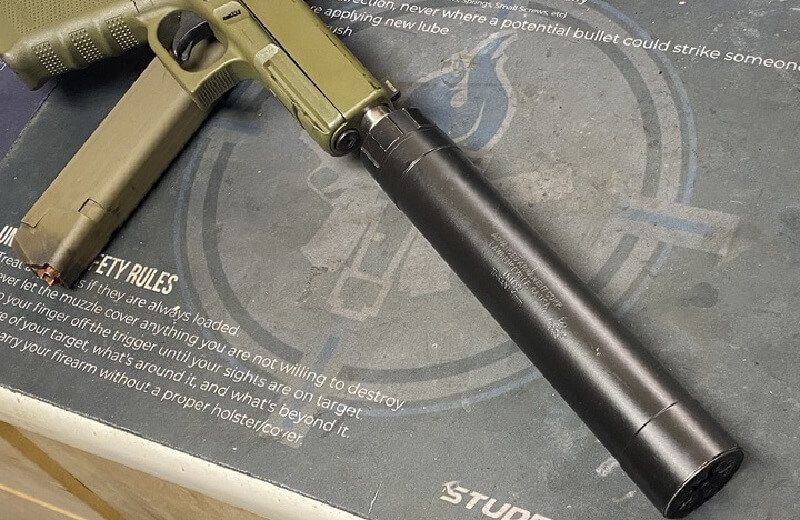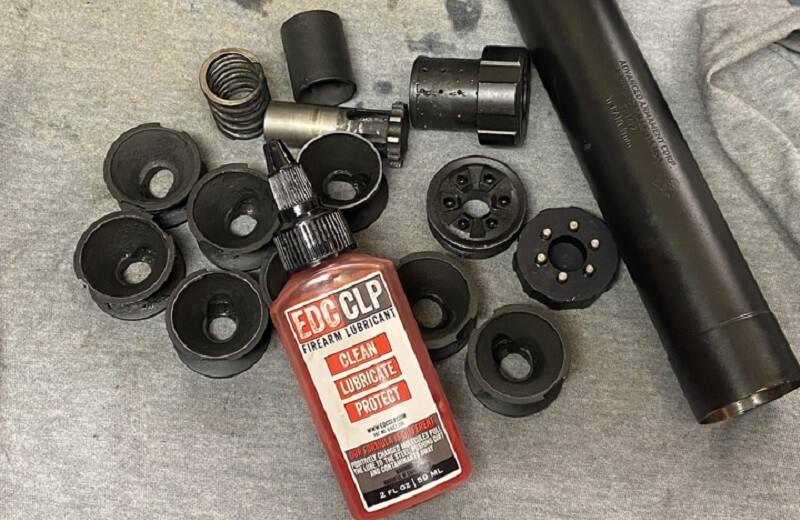Navigate This Post
Whether you call them suppressors, silencers, sound moderators, or just plain old gun mufflers, when it comes to cans there are two primary types: Handgun and Rifle. Naturally, rifle silencers are built to withstand the punishing gas pressures of centerfire rifle cartridges. Handgun cartridges, be they .22 LR up to .45 ACP, do not generate nearly the gas pressure or get as hot as their big brothers.
For this piece, we will consider the care and maintenance of pistol suppressors. Yes, care and maintenance does make a difference. For the sake of this article, we will put .22LR cans in the same class as pistol suppressors.

The author’s GLOCK 17 with an AAC TiRant pistol suppressor.
Taking Apart Your Pistol Suppressors.
Help us combat Censorship by joining our Newsletter
If you are a suppressor veteran, this might seem sophomoric to you but, do a new can owner a favor and pass this article along to them. Aside from the internal construction, one of the biggest differences between a pistol can and a rifle can is the fact that a pistol can is designed to come apart, rifle silencers are not.
There is a very good reason that .22LR cans and pistol suppressors come with instructions detailing how to disassemble and then reassemble them; pistol cans get dirty, extremely dirty.
Most silencer makers will provide special tools with the handgun silencers that allow you to take them apart. Do not lose or misplace these tools or the instruction manual that came with the can.
Cleaning after Disassembly.
If you happen to own a .22 can or any handgun suppressor and have never taken it apart, even after hundreds or thousands of rounds, you need to reach for a bottle of solvent. *CAUTION: Handgun suppressors use a variety of metals, including aluminum. I would NEVER use a caustic or toxic solvent on a suppressor. My go to solvent is the one made by Froglube. Yes, it is mild, but it will not ruin your parts.
Should you happen to have a pistol can with years of baked-on carbon; find a plastic tub, lay the suppressor inside and pour in enough solvent to just cover the can. Now, go find something to do until the next day. Beating the baffles out of your can with a hammer is not recommended, so have some patience with your pistol suppressors.
Next, follow the manufacturer’s recommended guidelines for disassembly. Depending on the maker, you may have a mono-core baffle (single piece) or numerous cone shaped baffle pieces. The mono-core units are simple. Scrub all the baked-on carbon off of the core, clear out the body, wipe it all down and put it back together. For units with multiple baffles the idea is the same, but you have more parts to scrub. Those who are cleaning a can for the first time may be surprised at just how dirty they can get.

The AAC TiRant pistol suppressor disassembled for cleaning.
Lubrication is your Friend.
Every manufacturer of rifle silencers that I have ever talked to has warned against running their cans “wet”. Putting lubrication into a rifle suppressor can create dangerous pressures that could damage or destroy the unit. Rifle cans stay clean because they get hot as the devil from the gas. Pistol suppressors don’t get that hot.
When it comes to .22LR or other pistol suppressors, most of them can be run wet or dry. A wet can is a few decibels quieter. A dry can is still hearing safe. After you have cleaned all the carbon and nasty gunk off of the baffles of your pistol can, I recommend putting your favorite lube onto each one of the parts. This not only makes reassembly easier, it makes cleaning the can less of a chore next time. I have had great success with the red EDC CLP for the last few years.
The down side of a wet can is that you cannot get around some of the lube escaping from the chamber during firing. If you are using a pistol caliber carbine or sub-gun, this is not all that noticeable, with a regular handgun it is. Live life however you choose. You’re an American.

After cleaning, the author lubricates all of the pieces before reassembly.
Holes and Chambers.
From a very basic standpoint, a suppressor is designed to capture, cool, and slow-down the expanding gasses from the cartridge. Way back in 1902, Hiram Percy Maxim realized that it was the expanding gas that made firearms noisy. His patented “Silent Firearm” captured and cooled the gas before it could escape the muzzle, thus reducing the noise to the point that it would not damage hearing.
You might be surprised at how many holes and chambers are inside of pistol suppressors. When these holes and chambers become fouled with carbon and gunk, the effective noise-reducing ability is lessened. It is really no more complex than that. Cleaned and lubricated silencers reduce gunshot noise better than those with two years of baked-on carbon and other crud.
The moral of the story is easy to see. A clean can is a happy can.
Professor Paul Markel
Latest posts by Professor Paul Markel (see all)
- Tactical Masturbation: Top 3 Stupid Human Tricks - July 8th, 2024
- Blood Trail: Fearless Fiction - June 21st, 2024
- SOTG and SB Tactical Celebrate Brace Ruling - June 20th, 2024
- Shotgun Accessories: Practical and Useful - June 14th, 2024
- Tactical Rifle Tips: Transition Drills - January 5th, 2024






Recent Comments